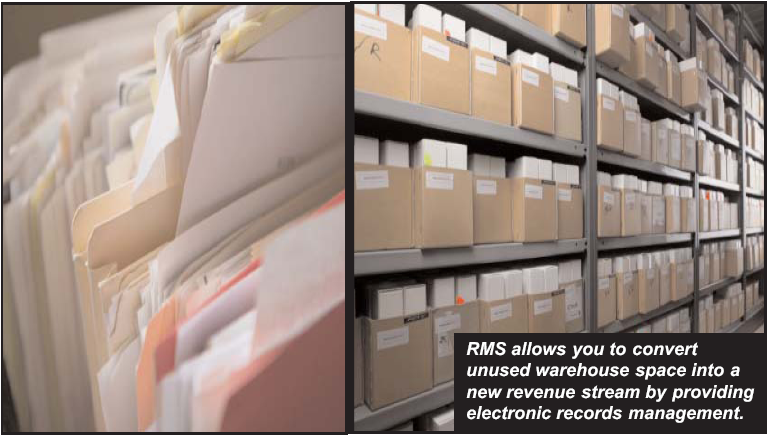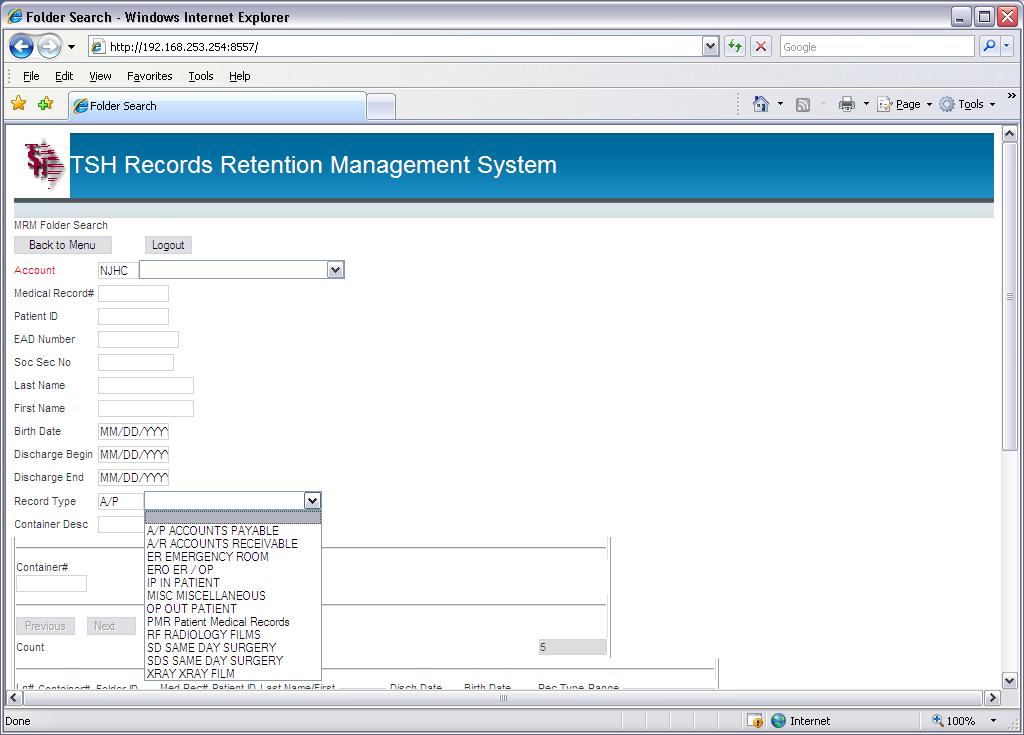Records Management System (RMS)
From The Systems House, Inc. is an integrated solution that manages the off-site storage, retention, and retrieval of all types of physical records. RMS is currently in use managing documents as diverse as patient records, X-Rays, fetal monitor tracings, as well as payroll, accounting and human resources corporate records.Using a web-enabled database approach, RMS manages the entire process – from the receipt of the records, locating the files in storage, responding to retrieval request, and ultimately to document destruction. The system is automated using bar codes and wireless technologies.
The system is multi-facility and multidepartment by design. Extensive security is built into the product to insure that only authorized users gain access to the records that they may view and/or retrieve. Many companies generate large volumes of documents that need to be stored and managed. With RMS, you have the tools to provide this service to your clients. Not only will you reap the benefits of this additional revenue stream, but you will also strengthen your relationship with your clients by providing these services.

RMS Features:
|
Key Benefits:
|
Click to view larger image
Container Storage:
When records are ready to be stored off-site, they are cataloged
using a web-based program, and placed in bar-coded containers for storage. The
container is the primary unit of storage, and can be defined to suit your needs.
A container may include multiple “folders”. Folders may contain paper records,
sleeve(s) of films or electronic media devices/disks. As items are placed in
containers, the information is entered to build the “container file” on the RMS
system. Pertinent information relating to each folder’s contents is entered, so
that it can be later located for retrieval. (Some examples
of information to be recorded: Patient/Client identity, Record type: Paper,
Microfilm, Imaging film, etc., Facility, Department, and Group identification).
When the container is “full”, a pickup call is made electronically over the web.
Container Tracking:
The container is tagged with a pre-printed bar-coded label.
RMS tracks the location of the container from pickup to its placement in the
warehouse. The initial scan occurs when the messenger comes to pick up the
container. It is scanned once again when brought to the warehouse, and lastly
with its location when stored in the warehouse.
Record Retrieval:
Requests to retrieve records are made using a web-based procedure. Each
user’s logon is coded to grant them access only to those documents that they
have permission to use (by location, department, and record type). A control
number is assigned to each request, so their status can be monitored by all
parties. To locate the required document(s), the user is able to search the
document database by the data elements entered when the container is stored.
This might include employee or patient name (or code), birth dates, range of
storage dates, document types etc. The details of the request, (for example; fax
a specific document or send the entire container) and the corresponding delivery
method (fax, ship, stat, or regular) are entered on the request and transmitted
to the warehouse. At the warehouse, a ticket is generated with the request
details. This information can be downloaded to a wireless or handheld device for
RFID fulfillment, or printed for manual retrieval. The status of the request is
recorded at each stage, creating transactional files and a complete audit trail
for each item. Upon delivery, a handheld device captures the delivery date,
time, location, and signature of the recipient. Subsequently the return of the
document is recorded (if
sent), so that the location of all documents are always known.
Inquiries:
With RMS, you can review the status and transactional history of a specific
record or group of records. This includes ability to see contents of a given
container with drill down to view the specifics of the documents in that
container.
Billing:
RMS generates billing for services provided. Monthly billing for storage is
based upon the number of containers (or jackets) stored for each client.
Transactional services are billed on a per service basis, generated from billing
files which may vary by customer and department. Billed services include: pulls
and re-files, Pages faxed, stat requests, courier charges and container pickups.
Charges for additional services can be billed as desired.
Reports are provided to monitor record retention and advise when
records can be destroyed.
With Records Management System from The Systems House, Inc.,
the entire document storage process is managed electronically with
security, efficiency, and reliability. Our comprehensive system
allows you to capitalize on your empty warehouse space, improve
customer relations by providing multiple services and increase your
contact time with your customers.
Call 1-800-MDS-5556 for a FREE demonstration in your office.
Or click here to tell us your needs.


